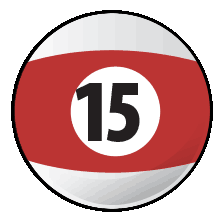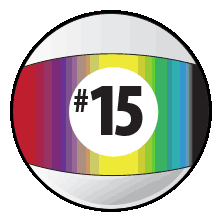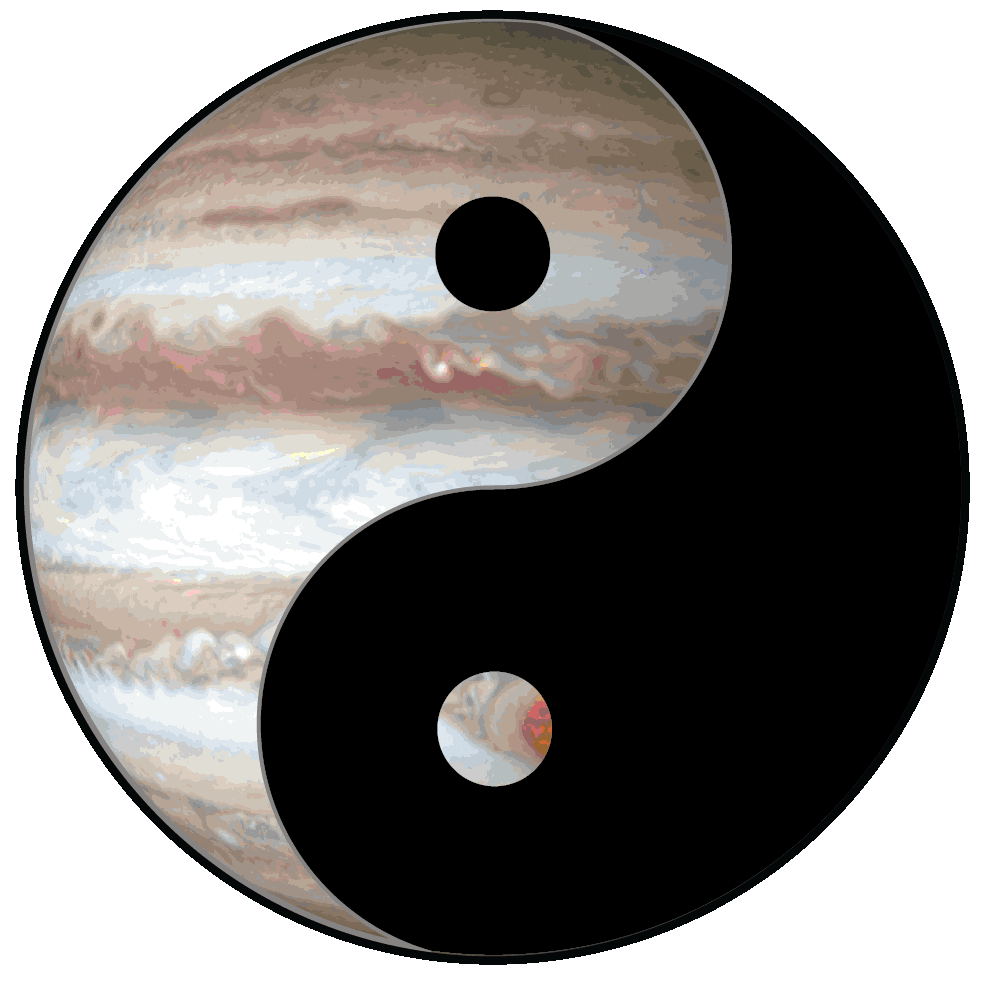In a nutshell / loops of chords. A chord progression is simply a loop of chords created by following along with a song's melody or bass line story. Over the centuries now, some progressions have become their own phrases too, of course, and these have been built into songs and forms. Many 12 bar blues songs are created this way. |
|
Like countless scholars before us, we use these historic progressions to start the learning process here. By rote learning a few, we'll have a good start. For new songs are written every day, often basing their chord progressions on the 'tried and true', of 'three chords and the truth', the One, Four and Five chords, both major and minor. |
Adding in chords. In the following method for learning the Americana musics, near all revolves around three chords, the '1 4 5' of any key center. So by adding in one new chord at a time into this progression, things evolve. We can simplify too of course, from '1 4 5' to just one chord, or two etc., all good. These one and two chord progressions we often call vamps or montunos. So once the diatonic ideas of One / Four / Five theory is super rote set, we just jazz it up from there, finding spots to place each of the 12 pitches in both melodies and chords within our progressions. |
Motion to Four / root motion by perfect 4th. That most Americana songs and stories find their own sense of gospel by moving to Four, we'll find all through the styles / literature. Yet, how's it done will always help us understand the music style. A pop styled song borrows a chord or two from a jazzier chord progression and a new genre emerges. A delta style 12 bar blues songs gets counted off at 220 in a jazz club ... Yet ... it is still 'three chords and the truth right?' And while the chord progressions in most songs find their way to Four, most root pitch motion is also by the interval of a perfect fourth, or its inverse, the perfect 5th. We bring more blues and rock with moving chords around by a minor 3rd, or we can jazz near anything up with half step motion between chords. |
A closed loop. When performing a song, we'll usually go through the chord progression from beginning to end a few times, in some cases many times, to include enough choruses for the soloists. But by rote learning the chord cycle for song, we then just repeat it for each chorus. Beginning to end, then start again :) And then once committed to memory, when we play the song, we get to make it up, improvise it from memory as we move along in musical time together :) That similar sounding and storied songs have similar progressions of chords, adds to the fun of making music, as we the 'borrow' ideas from one another to jazz up each other :) |
A beginning and end. And since chord progressions have a definite beginning and convincing end, and we always go to Four, examining how we get there here becomes the style / number of chords evolutions. Thus back to the core UYM / EMG ideas and curriculums. |
Common style / root pitch moves. Since motion to Four is very common in all styles, the interval of a 4th is an easy way to move between chords in our progressions. Folk and country's 'three chords and the truth' move by fourths. Pop is all about motion to Four, or Four back to One. Next add root / chord motion by 1/2 step, one fret, the half step lead in, for a blues / jazz way to work through the changes. Rockers love the minor 3rd interval between chords, nice and super epic stopping point on the way to Four for the big roar. |
|
Quick review. Thus, we 'UYM ~ EMG theorists' can view our chord progressions just like our other music study loops, as a sequence of elements with a closure. Building now on centuries of tradition, we can capture our various historical evolutions by an understanding of our chord progressions. Further, how over the most recent 100 years or so, how all our musics and genres have evolved collectively, through the cross pollinations of all the colorful harmonies within our chord progressions. And lest we forget, the challenge of an ever increasing complexity of musical art through chord progressions. And that we've a clear 'complexity' path to follow. New challenges bring new excitement for players, dancers and listeners, why ... everybody in the mix :) |
Learning to hear the changes by ear. Knowing that the vast array of harmony we enjoy in our Americana musics is a Euro invention all along, we can trace our studies to these origins and thus begin to build up the common chord progressions that we find all the through the Americana styles and genres. That we can follow the cycle of 5th's, tempered through diatonic realm, and near all is revealed. Further studies of chord substitution and 'modernizing the changes' flow from these essential progressions. And to hear them 'by ear', well that's the task at hand. All of the following examples are in standard tuning except where noted and rooted on 'C and A', the relatives of roots for major and minor pairings. Master these, and after a spell realize that for most styles, there's only a couple of places for the chords of a song to go, and most of what ya need is already under your fingers. |
C A- |
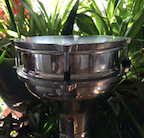 |
|
||
A- D- E- |
 |
|||
C to F |
 |
|||
A- D- |
 |
|||
C F G |
 |
|||
C D- E- F |
 |
|||
C G F A- G |
 |
|||
A- C F E- |
 |
|||
C E- F G |
 |
|||
F G A- |
 |
|||
A7 D7 |
 |
|||
C- Bb Ab G |
 |
|||
D- G C A- |
 |
Letters become numbers ... or not. Just turns out that music style factors right into how chords and their progressions are often identified. Either by letter name of a chord's root pitch or numerically, as in relation to a chosen key center. Three note triads are usually identified by letter. And when we add a 7th, we can sense a change a coming as the dominant spin begins. Thinking relative keys 'C' major / 'A' natural minor, letters to numbers for chord progressions.
|
Remembering that set chord progressions also shape our song forms, music style plays a big role here. On the folk side, chords and progressions are usually by letter. In the blues, with it's One / Four / Five, its very common to get just the key of the song, and sort it out by number from there. Key of 'A', 1 4 5 / A D and E chords etc. I'd imagine in pop, country and rock styles, artists identify chords by letter. Through the blues and on into jazz and beyond, numbers will often rule the day. In this book and method, we look to generate an androgenous, key center by thinking along the lines of a 'numerical perspective of the elements. |
So in the following explorations, we get to replace the root letter names with numbers to identify our chords and their progressions, within a key center. And like the various other music and math relationships here in Essentials, we create a central point, a key center, and simply count out from there. Once we're numerically thinking, we've all 12 of the tones from which to project the same 'theory of anything.' |
Roman numerals / major and minor. We theorists have another way to identify our chord progressions and the major / minor quality of triad we build on each diatonic scale degree. We can use the Roman numerals from olden days, numbers one through eight, to identify our numerical positions within a key center. That they exist in two varieties is perfection. Upper and lower case, so our major and minor? Yep. Upper case is major, lower case denotes minor. It goes like this. Our chosen key center is designated as the 'one', and we simply count up one through eight for our diatonic scale degree / pitches. We assign corresponding upper and lower case Roman numerals to designate the quality of the triad we build up on each scale degree. Do consider rote memorizing this next chart.
Cool? So this covers the designation of our diatonic seven pitches, so what about the other five pitches, as found in between these diatonic seven? Easy ... we use the '# and b' symbols to get in between and designate any of the possible scale degrees. And to designate color tones on any chord? We use just their regular numbers.
Chances are it'll get confusing at times, all this numerical / letters / scale degrees / colortone #'s, but it does for all of us at some point, so we're not alone in this struggle. Nice to know that there's just three basic number systems to rote learn and master. And that the numbers only go as high as 15, well #15 for some. And at this lofty elevation, we're off into another universe of music, with its newer theories, newer modal cycles of pitches, extended arpeggios, and weaving of the ancient colors. So, impractical for most of us merely mortal beings? Might be but then again ... :) |
This 'tonal center' is our tonic pitch, One, determined by the key center we choose for our song. And just like with measuring the distance between two pitches as an interval, its the same with our chord numbers. They simply reflect and measure the distance between chords, the bigger the number, the further the distance. |
And while there's considerations about 'which key', we don't worry about it here too much. For in the real world, the composer, a vocal range and playability of fingerings usually determine a song's key center. When all else fails, we can get the capo out and keep trying to find the right spot for all combined. In the following discussions, we'll jump around key wise a bit, mostly to tie these chord progression ideas into the guitar and bass methods. For there's just times we love our open strings for their 'full on extra bring it' magics, and sometimes we move it up by half step, or re-tune it up or down, to find our own right earth tones. |
Chord progressions / a bit of history. Of the three unique cultures of people that blended together here in early America, termed in this book as 'Amer Afro Euro Latin', all of their musics each started out as just one melody line moving through time. Theoretically we term this as 'monophonic'; musical art and its performance with one melody line. So, no bass line, no chords. Just a memorable sequence of pitches sounded in time. Folks sang along together with the melody notes on the same pitch, so in unison, same as today, and as things evolved, jammed along with the melody notes with the various flutes, 'talking drums', different sized drums. Before music notation, these melodies were orally passed along from one generation to the next. |
|
As these three musics independently evolved over many many generations of artists and players, two of these unique cultures, the Afro and Euro, simply began to add additional melody lines, to 'jazz it up' as we Americano's are fond to say, creating more of a 'weave' of two, three even four melody lines, all sounded together in creating the songs of the day. Theory termed polyphony, the second, third, fourth melody line pitches moving mostly together, which become a bass line in the low note and chords when all the pitches vertically align. |
From the Euro East. Over the developing centuries, the Euro version of this monophonic 'plainsong' styling, now 700 or so years old. Example 1. |
|
Adding a second line of notes below, then a third, a fourth we gradually reach our bass, tenor, alto and soprano voices in a four part choir. This we translate to our chords and have for the last couple of hundred years or so, at least since the early 1650's with French composer Lully, a lute and guitar player, thus had a fair degree of tempered harmony / chords to work with, (and many other composers through Europe). |
|
And as a third, and even beyond to four and five voices were added to the upper and lower bass melodies, all combined to became less of a horizontal weave and more a vertical stacking of the pitches. First on the stringed viols and sure fretted lutes, and later on the various developing keyboard instruments, the horizontal weaving of melody lines evolves to a vertical stacking of the pitches into chords. |
|
The four lines of our harmony today correspond to the soprano, alto, tenor and bass of the vocal choir organization. And like mixing any sort of ingredients together, the more we define each one, the greater degree of clarity we can obtain upon mixing them together. As each pitch is more precisely tuned to a given standard, the better they mix together into coherent and recognizable combinations and patterns. So line by additive line, coupled with a more precise tuning of the pitches, our chord progressions have evolved over the last 500 years or so. |
|
And from the Africans. Over these same developing centuries, the 14th through 19th, the African musics developed a stringed instrument we know mostly today as a banjo. In both fretted and fretless models, in its supportive role to the voices, the banjo is capable of sounding both a song's melody, chords and bass line. All while keeping its motor and rhythms humming along nicely. So ... a portable piano? Yep :) |
We inherited an 'open G' tuning from the four string banjo. Its pitches form up and sound a 'G' major triad. When the first of the Spanish guitars migrated up through Mexico into Texas and beyond, artists tuned it to open 'G' and just kept right on going with their musics, now with a bigger sound and new tone. This combo forms the basis of our early blues songs. The relative ease of the open tuning accommodating the creation and further adaptation of endless chord progressions. |
'Amer' traditions. Our indigenous Native American peoples' musics is a plainchant styling of music making and ties into the now ancient traditions of folks raising voices together in community ... ... where everyone sings the pitches of the melody line together in unison, so no harmony per se. Sound familiar? Ya ever done this? Harmony, stacking pitches into triads or chords, is just not found in the historical record of these artists. The plainchant styling goes all the way back into our histories and of course continues today, near every time there's a sing along of voices together. So ... singing "Happy Birthday" at the party is plainchanting? Yep. Only after the combined Afro / Euro musicians arrived, each with their variations of stringed instruments and ways of tuning, did the Amer / Afro / Euro music melding of melody and chords begin in earnest. Our 'lines now had changes.' From these peoples and their music we get a fundamental part of the 'motor' of our musics. Termed here as the 'big four beat', this is the heartbeat that becomes the basis of the 'swing' feel of our rhythm, that has brought on the smiles of all listeners globally. And while 4/4 time is a basis of musics everywhere, it was here in America that our marching music took on the distinctive accents on the 2 and 4 beats, which when consistently sounded, creates the Americana swing. |
|
Zan's Celtic four chord vamp. I learned this chord progression from a friend just the other day. Zane said it's Celtic and motors nice in 3, (123123) or leans 6/8 (123456123456) depending on the subdivision you chose. Makes a nice loop in 4/4 too, so rock and blues leaning. Example 1a. |
 |
Cool yes ? And catch the bass motions ? Easy do with root positions chords. Thump the bass note and play the chord :) Just an easy trick to set up the top of the phrase. Hearing a song in these changes ? Need a bridge ? Alternate and additional motions. We can jazz up the following progressions lots of ways, some of which take us back to our Celtic songs. E- / B- / C / A- E- / B- / C / D E- / A- / C / D
|
|
'Folia', an old chord progression. Into the waybac to find the source for this next chord progression. Probably created before the full acceptance of equal temper tuning, "Folia" is a sort of lovely minor keyed ditty whose bass line and basic harmonic motions could have spawned such top 10 hits as "Scarborough Fair", "The Rising Sun Blues", "Ferry Cross The Mersey", to name a few. And fro pro leaning cats, all well worth becoming acquainted with. Get hip to some of the first changes from across the pond. Example 2. |
|
 |
Cool huh ? Hearing any other songs similar to this progression of chords? No surprise. What may come as a surprise is that there's no Four chord in the progression. What no Four chord? So ... no gospel? Not just yet ... |
And a not quite so so old song and chord progression yet, perhaps an original of the 'diatonic 3 and 3 songs?' Set the waybac for 1685 or thereabouts ... 1685 ? Oh, cool. Surely a big year for us chordal cats. And back across the pond we must go, with the glories of harmony on the cusp of bursting forth from the new 'piano forte', then just coming out of Italy, we get an original song of the 'major / minor weave of the triads', into what will become the basis of oh so many of our tried and true chord progressions, in all songs that we've been writing, and that we will be writing today and tomorrow. So does this next idea sound somewhat familiar? Example 3. |
|
 |
Cool. Yea, first the bass line story and then the basic changes of Pachelbel's Canon in 'D.' Just a super solid, near 400 year old chord progression. And depending, easy to sound with barre chords or even a slide. And about the 'diatonic 3 and 3?' We got five out of six of our diatonic triads in the one lick. What? 'Only five out of Six?' Ah ...but an easy fix :) Here's an 'adjustment' so as to include them all, all six chords of the 'diatonic 3 and 3.' The three major and three minor triads of any key center. Example 3a. |
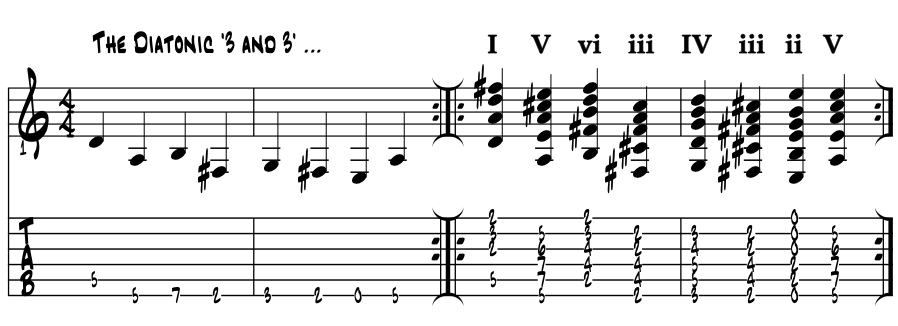 |
New root pitch in the bass line, changes our story a wee bit. So an evolution yes? And the last Four chord becomes a Two chord? Yep. So now we include all six triads in just a couple of bars. Meaning? Well, we got our 'theory arms' around the resource. 'Near the whole tamale now.' We've located the diatonic triads, we know where they are now, so when we're missing a piece of the puzzle we're working on, we'll know of a few possible chord solutions to begin the search. And near the whole tamale? Well, seven pitches in the diatonic scale yes? So there's a Seventh note, a mode, a triad built on vii, and a Seven half diminished 7th chord. Yet, most of our chord progressions for a song, from folk through pop, blues, rock and country, most are created with the 'diatonic 3 and 3.' Turns out that most things with Seven, we put atop the 5th scale degree, the dominant, and call it some sort of V7, saving the half diminished 7th chord for more the blues and jazz styles. |
Motion to Four. In this primer, the harmonic motions we use to get to the Four chord forms the crux of the theory of chord progressions. For in near every song in our Americana songbook, or even in every song, depending on the book's music style, that in telling its story, the chord progression of the song finds its way to Four, the Four chord, in both major and minor keys, of the key center chosen for the writing of the song. So ... |
These next few ideas and discussions of chord progressions center around the motion between the One and Four chords and vice versa, moving from Four back to One. In our Americana musics, this is where the 'gospel' quality often originates. And it just turns out that how we 'get' to and 'from' Four, which of the chord progressions we use, helps determine and characterize the music style we're leaning towards. Thus empowered, we can evolve our art through a merging of styles. |
Core of it all. Is motion to Four at the core of it all? For some it could very well be. For in this back and forth is the essential DNA of our own Americana gospel. In any music style telling any sort of story, if ya want to testify' a bit, bring some gospel to the discussion under way, go to Four. And stay there for a spell :) This first idea is in 'E' blues. First chords then a suggested riff, which as written, doubles as a bass line too. Example 4. |
 |
Cool? Sound familiar? It's everywhere in our musics of course. As time and all permits, find a version of the suggested "Turn On Your Love Light" and jam along, finding the One to Four motion and have some fun. The Grateful Dead version is in 'E', so they get the myriad of different drives with these big open notes. |
|
The big tone. Get a nice big tone with the open notes yes? Cool. We bass players love them too :) We quickly realize here that this bass line, created with the pitches of the major triad, is also a major style 'influencer.' And adding in a tempo and style of rhythm, i.e., a groove, we've just illuminated the bass line / chord basis of about half of the standards in our blues, rock, country and pop songbook :)
|
And flip it on over for the 'B' side. And near just as popular of course, is starting on Four gives us a place to go to. One? Sure why not. Bass line first. Example 4a. |
|
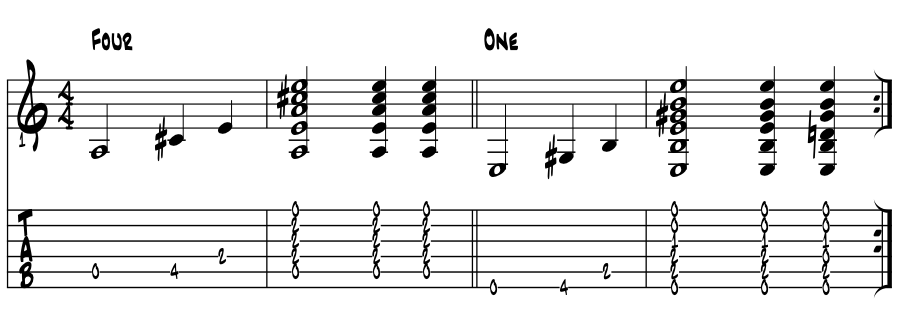 |
Here's this last idea, Four to One, in 'A' minor. Ex. 4b. |
 |
This minor '9' chord voicing in the first measure above is a keeper for certain. The One chord is maybe the most common of the fast moving Two chord shapes available. |
Passing chords between One and Four. So if getting to Four is a main focus of our chord progressions, we must have a few other ways to get there yes? Sure, and these ideas, here using triads, is tried and true solid thanks in part to the bass line. Thinking 'C' major. Example 4c. |
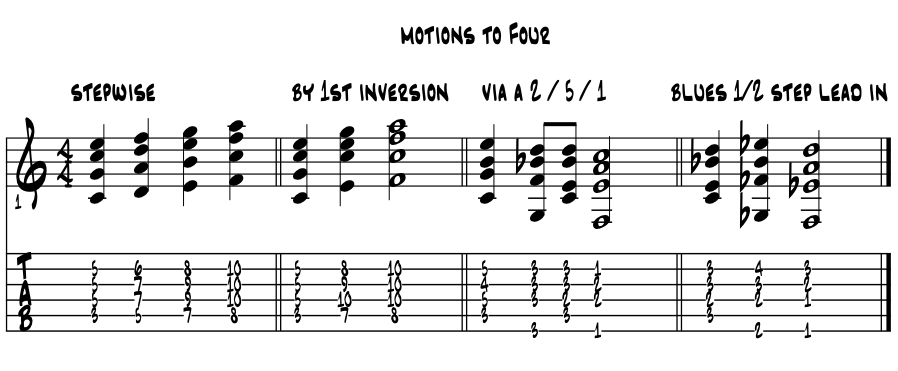 |
Sound about right? Diatonic stepwise motion. Solid 1st inversion, 'E up to F' root motion by half step. Jazz it up with the sleeker Two / Five into Four styled motion. Then with some V7 blue colors, and resolving to Four from 1/2 step above. |
Motion from One to Six and back. While motion to Four is where most of our chord progressions got to, the diatonic One and Six are the two relative 'poles' of tonic stability we often seek. One, as major, Six as minor, we get the best of both under the one bigtop. Example 5. |
 |
Core of it all? Could very well be. Our two tonal centers paired under the 'relatives' of major and minor, Ying and Yang. Here's the flip side. Minor to major. Example 5a. |
|
 |
Lots of ways to evolve this motion to tell our tale. Remember this piano '1/8 note figure' from the 1950's 'do wop' style of pop music? Example 5b. |
|
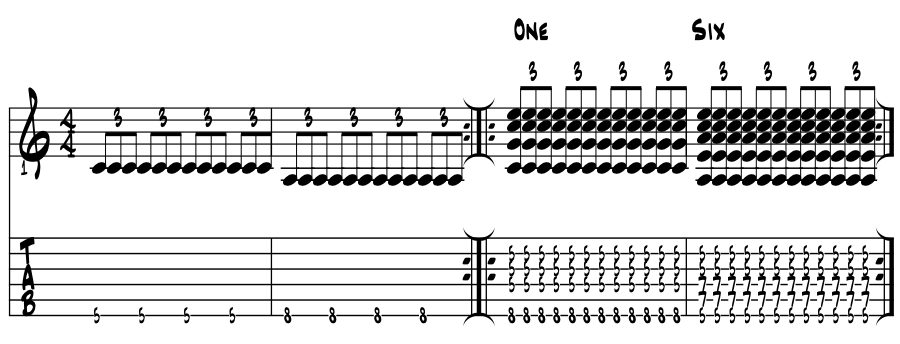 |
Look at all them black dots ! Wow. Luckily, once the chord is under fingers, it's all about the triplet groove. |
Motion from One to Six to Three. Relative major to relative minor, then by 4th to Three. Pop and jazz. C / A - / E - |
'X' Gen. Just seems like these changes come up a lot these days. Last time it was in a move score, the outgoing / roll the credits track. Find voicings for these chords from the changes above. Here's the root pitches of the progression. Add some fuzz make the big roar. Try 5'ths or barre chords for this root motion cycle. One / Three / Six / Five A- / C / F / E ... and commonly scented teen variation F / Bb / Ab / Db "Think from the root." |
Modal blues. Straight 5th's will work or triads with some fuzz. Bring these change to rock. E / B / A / G / E |
One, Six, Four to Five. This next idea is perhaps the most utilized chord progression we have in pop music. Often termed 'teenager in love' changes among artists, taken from the 60's top 10 song by the same name. And while it forms the basis of many songs today, it is also a very very common chord progression for intros and vamps, on through the styles and into jazz. Thinking in 'D' major. Example 5c. |
|
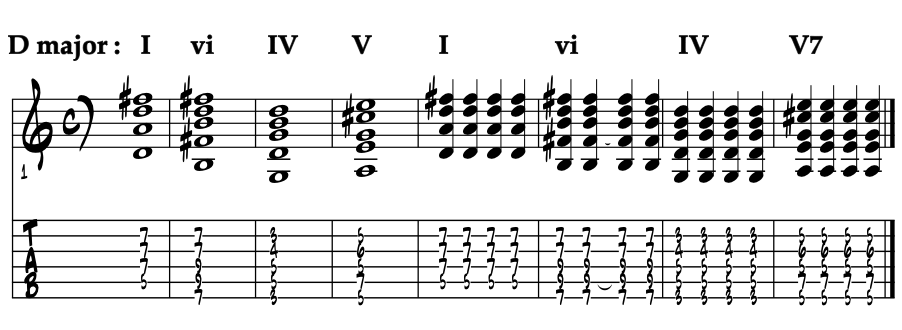 |
Easy to jazz up a bit as Four evolves to Two. 1 6 4 5 becomes 1 6 ... 2 5 So, mirroring the ideas above, here we find the Four / Five pairing becomes Two / Five turnaround. Root motion by 4th scoots right along :) Thinking 'D' major. Example 5d. |
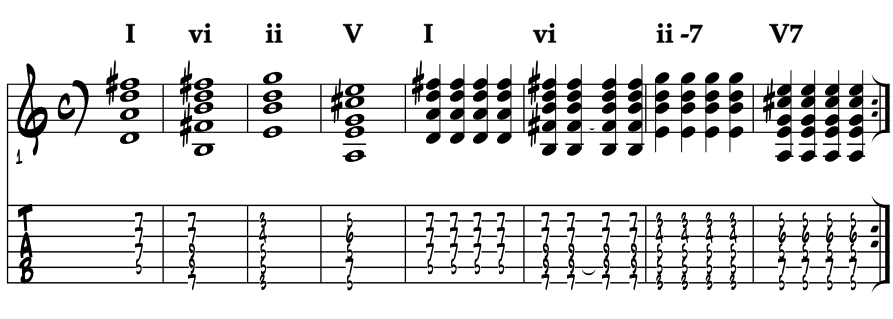 |
Sound a bit jazzier? And from this last idea, we can evolve the '3 6 2 5 wheel of magic' universal turnaround. One becomes Six and the new cycle is born. A jazz artist's bread and butter, often with a 7th added to each chord, its diatonic motion creates a sort of 'perpetual motion rhythm machine' for the advancing artist. |
One / Four / Five. This next chord progression gets more airtime than probably any other, and rightly so, as it'll rock the house both big and small. We're back to our One to Four motion, now with Five to close out the phrase. This next idea reminiscent of a song that has gone to #1 in most garage bands across America since 1966. Learn it here if need be. Example 6. |
|
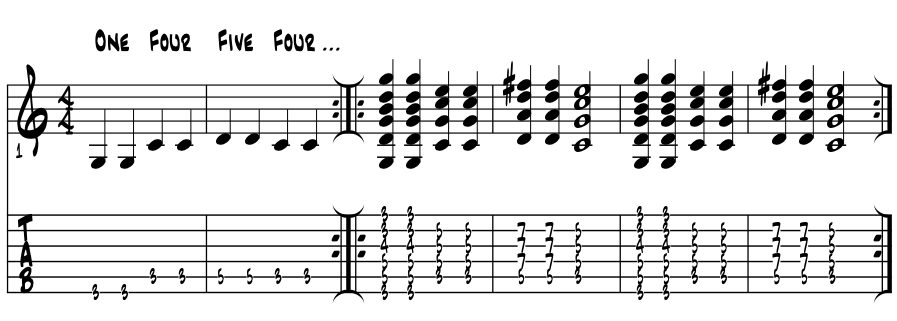 |
Know this progression? Do learn it here if need be. Just way fun. And surely add in your own style grooves and tones, find a hook and write a song or two ... for these chords are purest gold in rock and roll :) Folk, blues and country styles too of course. So, need to fill the dance floor right now? Count off a 'Good Lovin' styled song ... and behold its magical dance magic :) |
Basic yet cool. How do three chords light up stadiums of fans? 'Three chords and the truth' and some blues hue ? |
One / Four / Five in minor. Here's the same motion in minor. Thinking 'E' minor. Example 6a. |
|
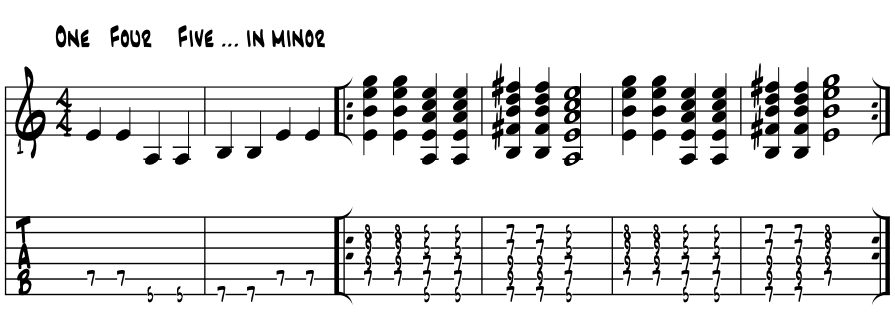 |
Chord progressions in the minor keys have just as wide a variability as with the major keys. And maybe even more so. For in minor, we get to add in additional pitches to our diatonic core of seven pitches with the harmonic and melodic minor groups, and the variable chords these groups of pitches can bring to our progressions. |
"Simplicity is the ultimate sophistication." |
wiki ~ Leonardo da Vinci |
Six to Five to Four ... and back. Sometimes known around generally as the 'Watchtower changers', this is the essential cadential motion in minor drives a lot of the Americana magics. The Five up to Six in the middle, then the is direct from the closing phrase of the now near ancient "Scarborough Fair." Here parodied some in "C#" minor, as lifted off a recording. Ex. 7. |
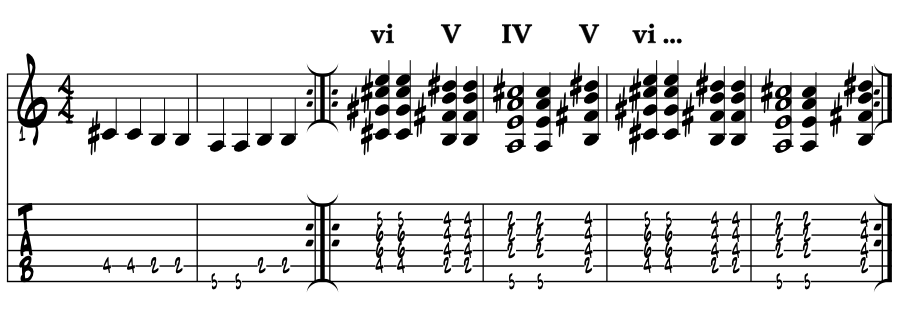 |
Lots of our Americana heros covered this song. Everybody in the room usually knows it too, so it's a fun jam tune. As Americana as it might ever. Heavy jamm tune, learn these changes here if need be. |
Variation. This next idea comes right off the last one. Moving to 'E' minor, it's basically a Four / One / Five in major, but kicked off with with their relative minor tonic chord / vi. Often built into a nice jamm loop of four bar phrases, it has a sort of 'epic' quality that loops. Ex. 7a. |
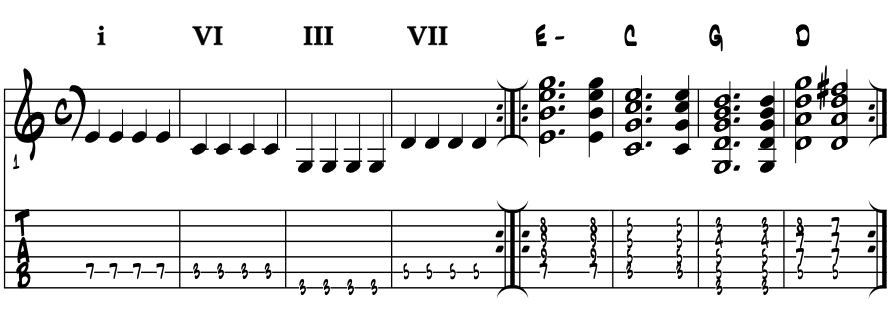 |
Variation. Always nice to have something 'epic', never know when the Queen's going to show up :) Very user friendly changes to solo over, did you catch the closing '4-3' suspension in the turnaround? 'Epic + upgrade' :) |
Four / Five / One becomes Two / Five / One. Continuing our evolutions here, we being a mix and match of major and minor to create a cadential motion for the major key. In 'C' major. Please examine the letter name pitches as we spell out the chords. Example 8. |
C |
E |
G |
B |
D |
F |
A |
C |
|
Four |
F |
A |
C |
. |
. |
. |
. |
. |
Two (- 7) |
D |
F |
A |
C |
. |
. |
. |
. |
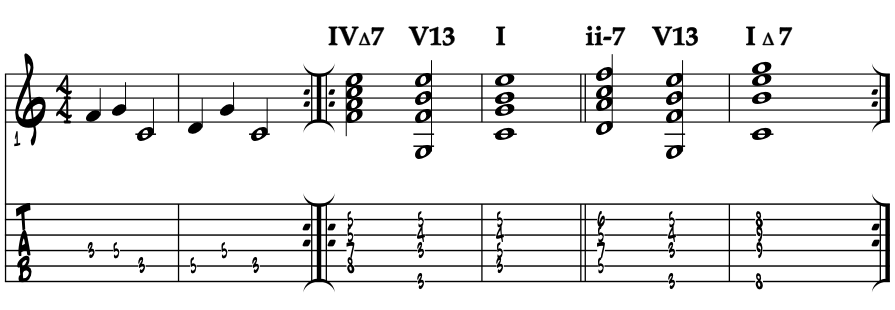 |
And right under our nose ! Catching the 'F' major triad in the upper part of the 'D -7' chord ... ? A slight shifting along the arpeggio stream of pitches creates a new way to set these critters in motion. And the new bass line? Probably the same story, but with a new twist :) Ex. 8a. |
C |
E |
G |
B |
D |
F |
A |
C |
|
Four |
F |
A |
C |
. |
. |
. |
. |
. |
Two (- 7) |
D |
F |
A |
C |
. |
. |
. |
. |
Song starts on a Two chord. Every once in a while a song comes along that wants to start 'on its way' to some resting place (usually One) in the future. And the Two chord is a perfect way to start. Most notable standards include the jazzy ballad "As Time Goes By" from the famous movie and early 60's rockin "All My Loving." |
|
Tritone sub, mostly a jazz motion. This next idea evolves the Two / Five progression just above, and is a potential 'super super' game changer. For in one theory move, and with a couple of chord shapes, we create new pathways of accelerated sleekness and an ability to bring the swing. Thinking 'C' major, 'G7' becomes 'Db7', thus our name of tritone sub.' Please examine the letter name pitches and then their realization. Example 9. |
C |
E |
G |
B |
D |
F |
A |
C |
|
V 7 |
G |
B |
D |
F |
. |
. |
. |
. |
bII 7 |
Db |
F |
Ab |
B (Cb) |
. |
. |
. |
. |
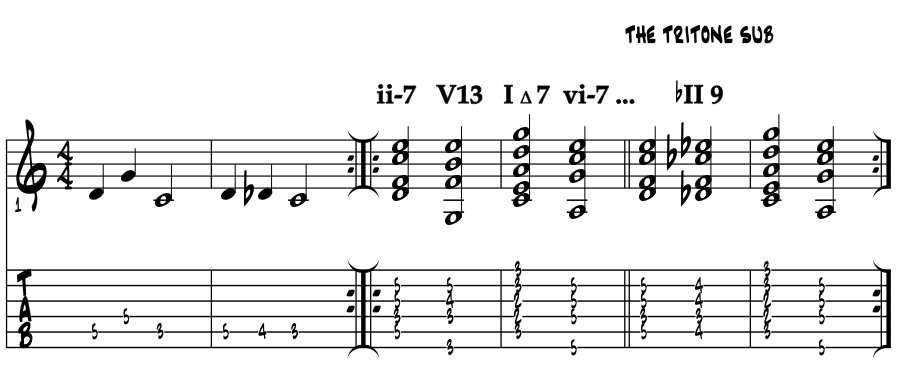 |
Cool and easy huh? Two / Five is the sleeker jazzier 'go to' motion. And in 'jazzy standard songs', most anywhere a composer goes we can find a Two / Five cadential motion to get us there. This 'cell' of chords gives us something to extra to work with. Is the tritone sub the organics for the half step lead in? Could very well be. Is the tritone sub chord part of the V7b9, multiple resolutions process? Yep. That's a diatonic, organic source for the theory of this substitution magic. |
One / Six / Four / Five into Three / Six / Two / Five. In this next evolution, the One triad now becomes Six, and the Four chord evolves into Two. Like 1 6 2 5, the sleeker 3 6 2 5 motion is a fun looping jammer, it's a cycle of fourths bass line story, a solid motion for intro', outro's and vamps. With the sleeker Two / Five motion, it's easy to begin to double it up into '3 6 2 5', creating a looping cycle that is ready to continue to cycle along, or resolve its motion and direction, if and whenever :) A slight shifting up in the arpeggios, examine the transition in letter name pitches. Thinking 'G' major. Example 10. |
G |
B |
D |
F# |
A |
C |
E |
G |
|
One |
G |
B |
D |
. |
. |
. |
. |
. |
Three (-7) |
B |
D |
F# |
A |
. |
. |
. |
. |
Four |
C |
E |
G |
. |
. |
. |
. |
. |
Two (-7) |
A |
C |
E |
G |
. |
. |
. |
. |
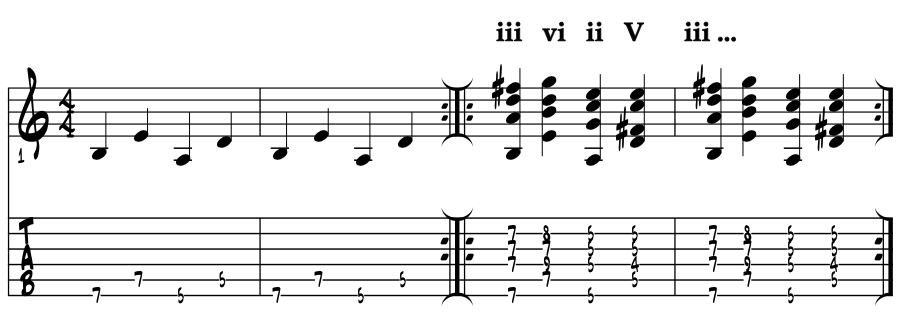 |
For guitarists, notice the bass motion as it moves across the strings by perfect fourth? This is a jazz players delight, as these sorts of motions, with movable chord shape or structures, can open up the harmony and possibilities rather quickly. With the right players and setting, this 'loop' can and often will, go on for a while. Makes for a good intro, and even a better outro, to build up a 'bring the house down' final hold. |
Evolving Six ( vi ) into a dominant chord / V7 of ii. Another 'stgc'er?' Yep, that's like 4 in a row :) Feeling a sense of a stylistic change in these chord progressions as these 'game changers' stack up? Cool, just jazzing it up. By adding one new pitch to our diatonic scale mix, the # One, we now have the pitches to build the Six triad as major, and then easy to diatonically evolve it to a dominant V7 chord type. This creates an almost perfect diatonic 'double Two / Five' motion, a whole step apart. It's also another step into making all of the chords in our progression a V7 chord type. Here thinking in 'G' major, examine the letter name pitches and resulting musics. Example 11. |
G |
B |
D |
F# |
A |
C |
E |
G |
|
Three (-7) |
B |
D |
F# |
A |
. |
. |
. |
. |
Six 7 |
E |
G# |
B |
D |
F# |
. |
. |
. |
Two (-7) |
A |
C |
E |
G |
. |
. |
. |
. |
Five 7 |
D |
F# |
A |
C |
E |
. |
. |
. |
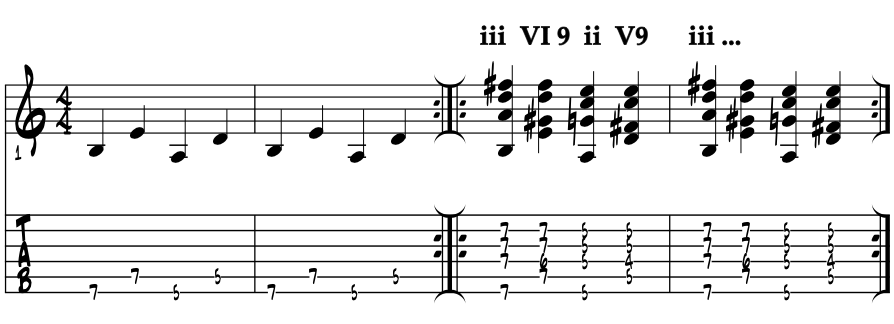 |
OK with the 9th colortone in VI and V ? Still blues and jazz, using this color helps to keep a common tone pitch between each pair, helping to glue together and sure up the motion. So just a sort of 'Two / Five' cycle? Yep. Or, a cycling of Two / Fives. And once we start these sorts of motions off, cycles and sequences and their combinations often become a mainstay of our art. |
So ... we borrowed a pitch to build up the VI 9 / 'E' 9 chord, so not purely diatonic anymore. Oh well, that's bound to happen eventually. To want to explore a bit beyond the boundaries. Is that grass greener on the other side of me vale? Sleeken the sleek. This next idea 'sleekens' our 3 6 2 5 motion even a bit more as we apply the tritone subs to our two dominant V7 chords. So, iii-7 / bIII7 / ii-7 / bII7 cycling. In root letter names our bass line becomes ... B E A D becomes B Bb A Ab ... Note the new motion in the bass line? Right, pure chromatic ... so as sleek as it gets ! We've reached supreme sleekness ... so in jazz style? Probably. Compare the two motions. Example 11a. |
G |
B |
D |
F# |
A |
C |
E |
G |
|
Three (-7) |
B |
C |
F# |
A |
. |
. |
. |
. |
b III 7 |
Bb |
D |
F |
Ab |
. |
. |
. |
. |
Two (-7) |
A |
C |
E |
G |
. |
. |
. |
. |
b II 7 |
Ab |
C |
Eb |
Gb |
. |
. |
. |
. |
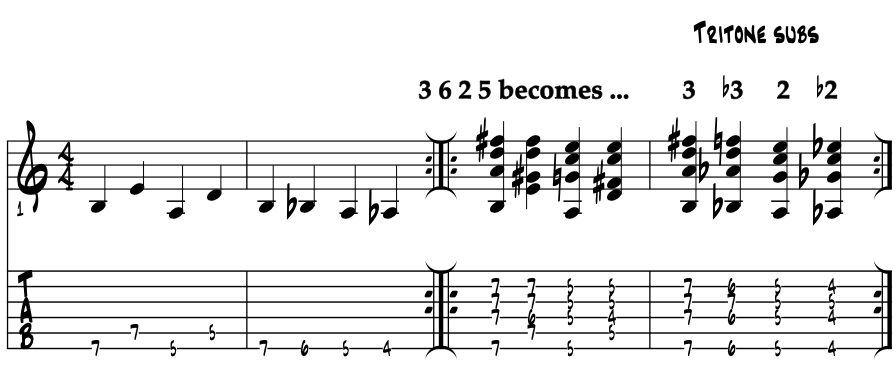 |
Sense how the chromatic bass motion and near vertical fingerings for the chords help accelerate the potentials here? Cool. That's the idea. On the one end of our spectrum, most folk songs like to roll right along, like riding in a wagon on a country road. On the other end of our music spectrum, there's jazz music that just want wants to go as fast as possible :) Like be able to jump high? Run fast? Think smart for a better way? All these joys have challenges built right in ... what are yours? |
Jazzy 'standard' changes. This next idea combines a lot of the above evolutions into an eight bar phrase. Motion to Four and then a 'standard' sort of way to work back to our tonic, One. In 'C' major. Example 12. |
bass line letter name pitches |
C I |
G ii |
C V |
F IV |
Bb bVII |
C I |
A vi |
D ii |
G V |
E iii |
A vi |
D ii |
G V |
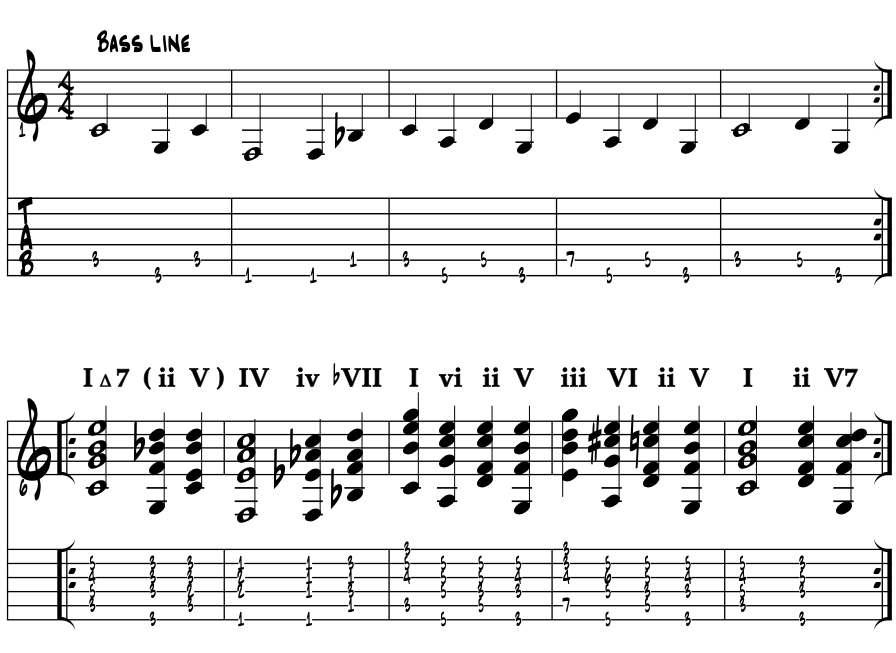 |
"Misty" changes? Yea pretty much. Ever consider soloing 'through' such a chord progression? Arpeggiating each chord? Yikes ! |
|
In this next idea, we illuminate the Two / Five cells in this chord progression. Example 12a. |
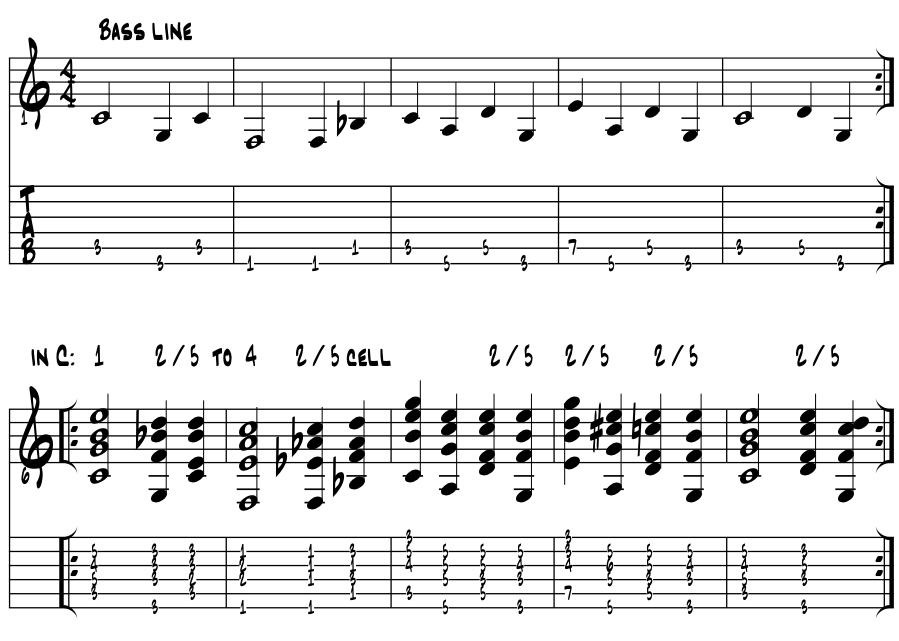 |
This last chord progression is really just a solid way to get to Four, and then cycle on back to One, via cycle of 4th's root motions of Two / Five cells. Cool ? |
Find a leadsheet chart for the ballad "Misty", written by master pianist and maestro Erroll Garner, and study a tried and true chord progression that is reflected in dozens of classic Americana songs. |
|
The 'granddaddy' of them all. 'The divvy up of the diatonic bebop Americana pie.' From the "Misty" changes just above, with composer Charlie Parker's help, we go further on up the road of finding new chords to arpeggiate / bluesify, slipped in between the basic chord progressions and cadential motions common to the jazz language. First, here's the bass line, and thinking in 'F' major, our fourth scale degree is 'Bb' yes? That's our goal in moving away from One, and from whence we shall return. Example 13. |
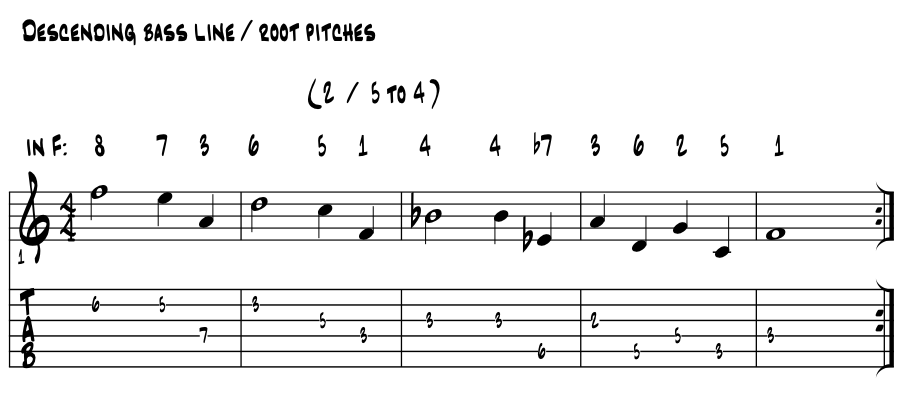 |
In this next idea we harmonize this mostly diatonic bass line with root position chords while adding in various color tones and 2 / 5 cells. Example 13a. |
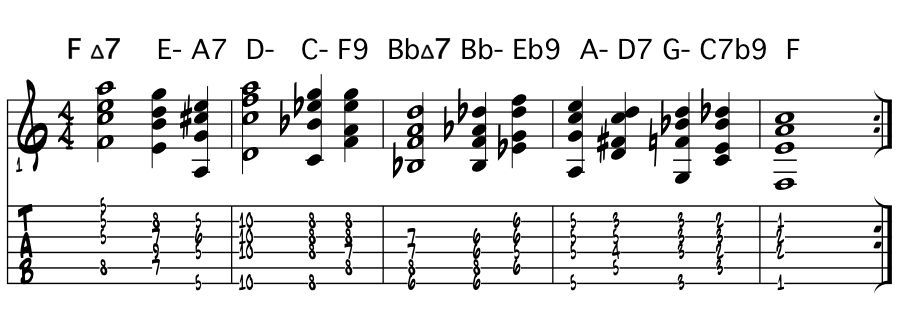 |
Surely a jazzy approach and a lot tucked into four bars. Feel the start point tonic 'F', then motion to Four 'Bb', and then continuing on to settle back and resolve to our original starting point? Cool. This sort of motion is core bebop changes, getting us from One to Four and back. Again the idea, that in jazzing up motion to Four, we give ourselves new opportunities to solo through the harmony of this essential, One to Four story line. Advancing the challenge? Yes indeed. And played in the brighter bop tempos, our task to improvise melody lines, through these changes, ramps ( vertically ?) right up. |
Not that we don't already have enough to work with ... but we can chromaticize this line with a few tritone subs? Sure why not :) Here's the bass line. Example 13b. |
 |
Here's a realization. Example 13c. |
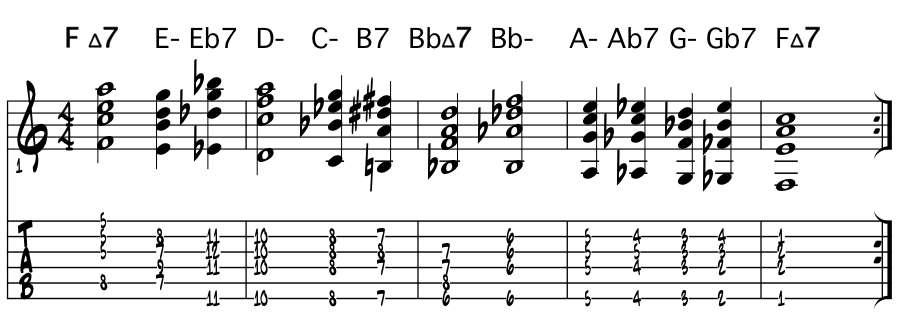 |
Cool? Again, surely a jazzy approach and a lot tucked into four bars. While we don't hear this sort of chord motion often in today's musics, in the bebop 50's jazz scene, it was a lot of their bread and butter. Yet even today, up and coming jazz players look to conquer these changes, and their endless challenge of creating of creating cool, blues infused, stepwise and arpeggiated lines that swing, as fast as they can. |
|
Author's note. Parker's composition "Confirmation", holds the musical elements to become the ancestral, granddaddy song of them all here in this UYM / EMG primer. For it sets the pinnacle standard for what an improvising artist can do, while still thinking and sounding diatonic. So like Bach, diatonically explore and exhaust through all 12 keys. With Parker? Similar 12 tone explorations within a diatonic realm, adding the pure Americana blues hue and accenting 2 and 4 of the big 4, the basis for getting music to swing in any tempo. |
For at university level music school back in the 80's, understanding this "Confirmation" level of Americana music sophistication was a goal. That mastering, or even attempting to 'theory understand' and master these "Confirmation changes", and thinking in a 'through the changes' approach to improvising single note bop lines, is a top step, if not the top step, towards one's own artistic and performance level and musical skills Parnassus. |
Historically, Confirmation's chord progression, and its tritone sub version, provided harmonic ideas and shaped a lot of what composers did after, on through the 50's. 'Hard bop' as it is often termed. Players arpeggiating the chords, or parts thereof, to make clear sense of where the music was going harmonically, through this then new '12 tone / root cycle by fourths / diatonic realm.' That yet retains the Americana gospel and a ton of blues. Yet the 'Trane' is still to fully arrive. |
And back to our theory discussions. Over the top ... too many chords? A dozen chords in like four bars of music? :) Still danceable? Still swings? No surprise that within a decade, so by the 1960's, there's an art 'reactionary' approach to such harmonic complexity. Two new paths evolve. One is a more modal, melody centered approach. These chord progressions are more diatonic, though now modernized by stacking their pitches into fourths, known as quartile harmony. The voicings often move chromatically to, and between one another. In this way all 12 tones are available. |
The second path of this 60's era is created by the elimination of the chords and harmony entirely. Often termed 'free jazz', with great freedoms come great responsibilities. And with musical art freedom, still making sense while moving through real time is a wonderful challenge. The combined melody and bass line story tasked to tell the tale. The artist 'fills in' their version of the story with single line melodic phrases. As lines line up, they can hint at possible chords and progressions. The harkens us back to the polyphony style of writing, popular a couple of centuries ago. |
|
~ stgc / super theory game changer ~ ~ Coltrane's "Moment's Notice" ~ ~ ... and this next idea ramps up complex ~ |
Moving beyond the perfect forth. First the theory, then the art. All of the above ideas all revolve around the interval of a perfect 4th. Motion to Four, Five / One cadences, 3 6 2 5 1 cycles, are based on root motion by fourth. So there's a super wide spectrum of songs and styles composed in this manner that includes near everything from the last four hundred years or so. |
This next evolutionary idea puts a new spin on motion by fourth. We can jazz up our diatonic '3 6 2 5' cycle with a bit of 'theory hocus pocus.' So, combine nuts and bolts perfect closure theory and 'slight of hand?' Yep. |
In doing so we can bring forth a new root pitch motion for our chord progressions. It's a same old Two / Five cell once the dust settles, but its placement in the progression is new and genius. So genius in fact, that in successive evolutions, we'll find and pass through the 'sheets of sound' approach and on into the realm of the 'post bop' harmony. |
So this next bit of theory of chord progressions becomes the 'giant step' that eventually opens up into the realm beyond the conventional root movement by cycle of 4th's, and off to discover new cycles, convergences and substitutions based on different interval cycles. Lest we forget that in our theory, 'all roads lead to Rome.' |
Based on the properties of V7b9, and the symmetrical minor 3rd, fully diminished 7th chord in its structure, we can move our Three / Six component of our progression down a minor 3rd interval, to create a new version of the double Two / Five. With this motion down a minor 3rd, our Two / Five cells are now a half step apart. Focusing in on the evolution of Six, examine the letter names as we spell out the various chords we commonly build on Six. Thinking in 'G' major. Example 14. |
scale degrees |
1 |
2 |
3 |
4 |
5 |
6 |
7 |
8 |
G major scale |
G |
A |
B |
C |
D |
E |
F# |
G |
diatonic vi |
E |
G |
B |
D |
. |
. |
. |
. |
VI 7 |
E |
G# |
B |
D |
. |
. |
. |
. |
VI7 b9 |
E |
G# |
B |
D |
F |
. |
. |
. |
full diminished 7th chord |
. |
G# |
B |
D |
F |
. |
. |
. |
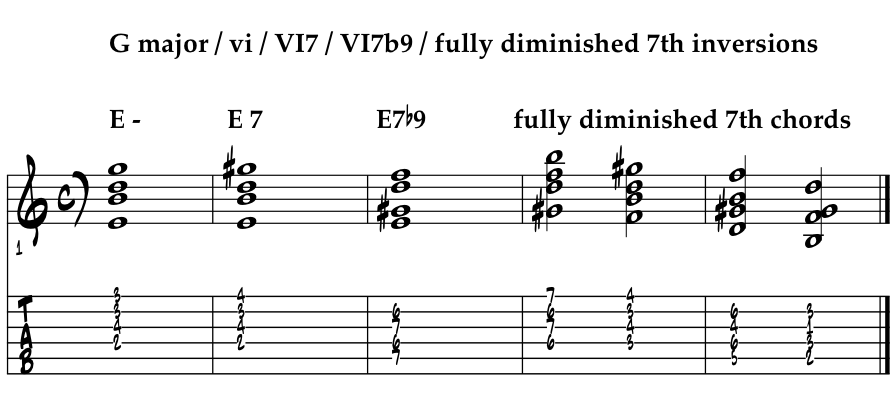 |
Hear the evolution of Six? Diatonic minor, then morphed into V7, then adding 'b9.' Extracting the symmetrical diminished 7th chord, then its motions by minor 3rds. |
So with the diminished 7th within the V7b9 chords, they move in minor 3rd's like butter. For guitar players, there's two handy diminished chord shapes in the last example. The first one, built on the upper four strings, is probably most common, and perfectly inverts its pitches moving up and down the neck with practice. Same with the second shape, though a bit trickier |
Evolving 3 6 2 5 with 'b9' diminished symmetry. In this next idea we move the '3 / 6' cell down a minor 3rd. This snugs it right up next to the diatonic Two / Five, by half step. Thinking 'G' major. Example 14a. |
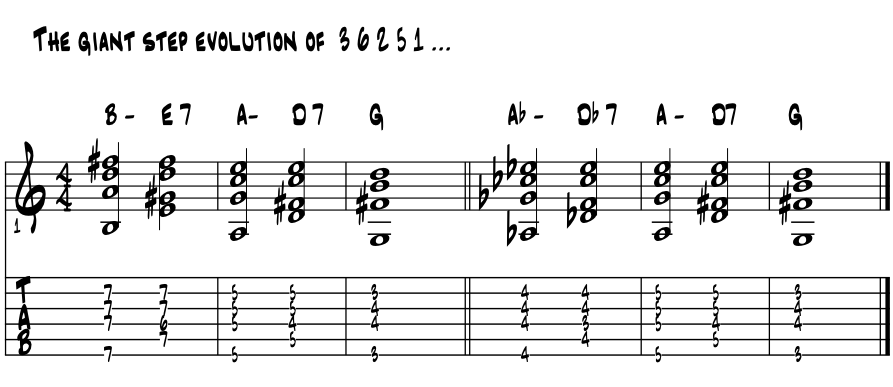 |
Easy enough huh ? Move 'B' and 'E' down a minor 3rd and they become 'Ab' and 'Db.' And from 'Ab' to 'Db' is a fourth. So ... minor 3rd / perfect 4th ? Yep. |
Yea, those in the know know, giant leap in the theory, all sorts of caveats to make this last bit a reality, at least in theory. And we softened the diminished color, V7b9 colors back to V9 ? We did. The theory got us the evolution, but ii-7 / V9 is plenty of color yes? We just use the diminished symmetry theory to get us there, then adjust our colors for the new creative space we arrive at. Please examine their letter name pitches. Example 14b. |
scale degrees |
1 |
2 |
3 |
4 |
5 |
6 |
7 |
8 |
G major scale |
G |
A |
B |
C |
D |
E |
F# |
G |
altered scale degrees |
. |
b2 |
. |
. |
b5 |
. |
. |
. |
bii / bV7 |
. |
Ab |
. |
. |
Db |
. |
. |
. |
b Two (- 7) |
Ab |
Cb (B) |
Eb |
Gb (F#) |
. |
. |
. |
. |
b Five (- 7) |
Db |
F |
Ab |
Cb (B) |
. |
. |
. |
. |
Not too many pitches in common with 'G' major ... so ? |
Where in the music? Very rare in written musics, though common enough in advanced jazz improv as a possible 'double 2 / 5.' Coltrane's 1957 song "Moment's Notice" features this 'double Two / Five.' And in this composition and this motion in particular, we can find Coltrane's initial step beyond the cycle of Parker's "Confirmation." |
|
This harmonic evolutionary process creates the super magical 'double Two / Five' cell, whose two components are separated by a half step interval. How is this innovation an evolution in theory, complexity and artistry ... an all in one? Well, we the improvising musician (us), now are tasked to come up with an idea, and half way through the sounding of this idea, we now get to modulate it up by half step up. Sounds like this. Thinking in 'Eb' major. Example 14c. |
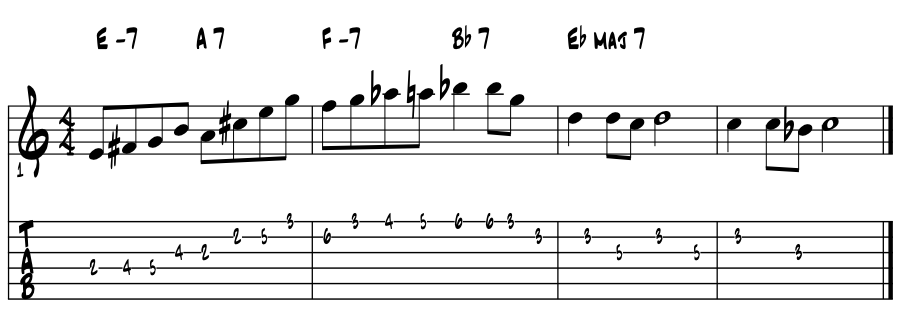 |
Ramp up the challenge. Hear the line modulate halfway through? Cool. Ever shape such lines in your own musics? If we add in the challenge of taking one motif per chorus, through the changes of a song, now with the 'double Two / Five' upgrade and wow, we've just really challenged ourselves. Boredom be gone !!! If there's some Two / Five's already under your fingers, this evolution is an intellectual one mostly. Though the shedding does begin a new, and for guitar players, there's a ton of linear ideas that 'move' by half step, simply by sliding an idea up one fret. Cheating? Naa, we've other challenges that reed and horn players don't have ... so maybe we're even :) |
|
And thanks to Coltrane, ramp up the excitement. Listen to the recording and marvel at the energy. Coltrane discovered this evolution over 50 years ago now and surely a lot has happened since. Yet, for the advancing improviser, this one 'evolution' can be a total kaboom. For now wherever a Two / Five motion comes up in our songs, we've an easy way to 'double the fun', in creating melodic ideas towards a resolution point. |
|
This 'double up' might be the easiest way in the book to 'go outside' a bit, then 'back inside', with a solid theory anchor in historical ground. Of course nowadays, we can do it wherever it seems appropriate, in whatever music. For the lick is surely in our jazz lexicon today. That it surely ramps up the intellectual and artistic challenge in one fell swoop is magic. That in all styles, grooves and tempos, while improvising, '... we find some space in time, Muse suggests an idea, we go for it and find the pitches, and during its sounding, move its pitches up by half step ...' Talk about adding some new sparkle to our lines, wow! Luckily, most of what we need to create at this level is already under our fingers. We just need to adjust our thought process, allow for time and space in the music to allow it to happen, and do the shedding to create the new neural pathways. |
“The most creative chaos and energy ... that beautiful kind of freedom.” |
wiki ~ Gabrial Florenz |
Evolutions of jazz harmony ~ V7 before every chord and the 'chromatic blur.' Since in any cadential motion the Five to One gets it done, gradually players started putting a V7 chord before any chord of a song's chord progression. This gives us a 'mini turnaround' to focus energy to any chord at any point in the tune. And further on down this path, each chord becomes V7. Click over to explore 'evolution of harmony in jazz.' |
Each musical style has its own fave loops of chords. Can we find the progressions of one style and morph them into another? Yep, we do it all the time. The 12 bar blues progression and form is a tried and true format that gets written in songs from every style and genre. |
Folk. Chord progressions in folk music love diatonic triads. And these are the open chords on guitar. There's a dozen or so shapes to learn, and a capo can do the rest. Fingerstyle motoring of the pitches with open chords goes all the way back. This brings newness to the now ancient chords and their progressions as each new artist comes along . And it turns out these chord shapes also work on certain Ukuleles. Open tuning is usually the blues pathway, but then there's the list of open 'G' maybe more pop hits that still fill the dance floor. The banjo also loves open 'G', it's an original Americana tuning. So lots to explore. |
Blues. In the blues we've the '1 4 5' of either major or minor, to fill the form, most often the 12 bar blues form. Jazz looks to evolve the motions between these principle chords with various substitutions. These give the soloist more opportunities to play 'through' the changes. |
Rhythm changes. Rhythm changes are mainly jazz chord progression that now goes back to the 1930's. Placed in a 32 bar form, there's four / eight bar phrases following an A A B A form. Rhythm changes, like the 12 bar blues, is a mainstay form for jazz. |
|
Bluegrass. Bluegrass musics love the 'diatonic 3 and 3' as it gives players more chords to solo through. For like jazz artists, bluegrass players are noted as improvisors and work both 'over' and 'through' the changes |
Metal. Metalists love the 5th's styled chords as these two pitched chords 'shred' right on up. For there's not a lot of confusion in the signal created by other chord pitches. So progressions are often chromatic, follow the blue notes or set into a loop by the composers. In between the 'shred' sections are often acoustic guitar and voice interludes, brief respites before the storm that comes. The progressions in these sections are often just the full triads of the song's chord progression. |
Gospel. Gospel music loves the diatonic chords within a chosen key center. Mostly stepwise, and there's always a motion to Four. Or, a progression starts of Four and works on back to One. In both major and minor keys, gospel progressions often get blues or jazzed up, depending on the preferences of the artist. |
Rock. Rockers love the blues and 1 4 5. As the various other genres filter in, folk rock, blues rock, jazz rock etc., they'll bring their own progressions along to flavor the music. Rockers love bar chords for making the big noise, get the 'house a rockin.' As the style now includes 60 or so years of songwriting, most any chord progression is found somewhere in the literature. |
Country. The chord progressions of country music follow right along with folk and the blues. So 1 4 5 and any mix up of the 'diatonic 3 and 3.' Here we've well over 100 years or songs to explore. And while anything might go anywhere, country songs usually stay within one key center , so diatonic, and stick to three note triads. Mix in some blues and rock into a country story? And add a 7th to some of the triads. |
Pop. Pop music and a pop song is usually built up around a 'hook.' So whatever best supports the riff is cool. With such a wide spectrum of songs in our 'pop' styles, there's unlimited range of its chord progressions. So back to 1 4 and 5 and the mix and match of the 'diatonic 3 and 3.' And then there's "Steely Dan." Well crafted pop music that mostly defies categorizing in terms of conventional theory of chord progressions. Big time jazz and blues influence in this music, so all options are available. Let the melody and bass lines decide. And before Steely Dan ?" "The Beatles ! " |
|
Jazz / chord cycles. Jazz players have the whole tamale to choose from in creating their chord progressions. All options, both diatonic and not, as well as all of the color tones are freely available to be mixed in. Jazz players love the 12 bar blues and rhythm changes, set forms of phrasing whose predictability of cadential motions provide a solid framework for explorations beyond. |
Harmonic motion / quartile harmony. When we move from tertian to quartile harmony, our sense of tonic, key center and chord progressions within composition take on a different dimension. Mostly a jazz quality, we hear some chords built in 4th's in country and swing. |
|
Turnarounds. The idea of a turnaround is just as the term implies, it's a way to get us back to the beginning of the form of a song, and its chord progression. For improvisors, mastering the 'through the turnaround' part of soloing becomes the portal to creating longer solos. |
Chord progressions ~ passing diminished chords. As tempos accelerated in bop and its post incarnates, the diminished colors becomes the great accelerator of American jazz. Thanks to its symmetrically sequenced DNA of minor 3rds, two solid theories emerge. First, simply that the diminished color can slip between two of any diatonic chords at the drop of a hat. Surely some are more common than others. Thinking in 'G' major. Example 15. |
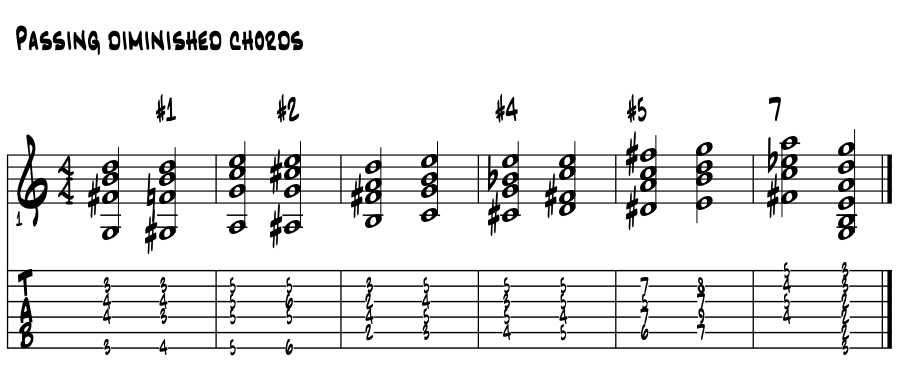 |
Cool ? Hear the 'passing chords' as we fill in between the diatonic steps ? Is this extreme jazzing it up ? Sure is :) |
Chord progressions ~ V7b9. The second diminished theory concept helps creates the various double Two / Five motions and chord substitutions. Based mostly on the b9 in V7b9, the fully diminished 7th chord in this dominant chord's tension enables and encourages chord motion, now moved around by the minor third interval. As the chord progressions in jazz music evolve, and lean more towards all chords being V7, and altered versions of this chord, we loose the more traditional 'motion by 4th's and move dominant chord colors around by the minor 3rd interval, as based on the motions from the diminished chord intervals. So wherever we need to go harmonically, we go. By fourth, half step, minor 3rd :) |
No Four chord? This 'motion to Four' DNA is quite possibly so strong in our Americana lore, that when we do not get to Four in a song, I think we really sense a different sort of energy and message, a restlessness in that song's story. For those readers here composing too, this 'Four / no Four' understanding can become another of our two part essentials, as say the relative major / minor pairing, for our balancing of Yin / Yang in creating musical art. Here's a chord progression loop that does not find the Four chord. Example 15. |
 |
"Giant Steps" changes? Yep. No Four chord but ... somehow there's that Americana gospel magic yes? |
The songs we love give us great progressions. That the music we each love to listen to, and play, is the best beginning source for understanding chord progressions. Covering a song, or making our own parody of these songs with new stories, built on the same chord progressions, is a way to create art and is a imitative process as old as the hills. Advancing what is already under our fingers is key in this evolution. For adding just one new chord to most any progression, opens a new dimension of the creative. Like putting in a Two chord before Five? Or even subbing in Two for a Four chord etc. We'll intuitively come to know when a new chord or progression feels right, is balanced, and becomes a piece in solving our composing and arranging puzzles. |
Supplemental songs. Since most all of the ideas on this page are 'in theory', click over to the supplemental songs page for ideas about chord progressions that we find within popular songs. In the listing of songs, the basic numerical chord progression is included. |
Take for example the 12 bar blues. Three principle chords, with really an unlimited degree of evolution through chord substitution, yet all within its traditional 12 bar form. There's songs in every style written with this three chord / 12 bar form. So for those that dig the blues, right in its chord progression and structure, there's a solid set list for the show, a wide style universe to explore its chord progressions. |
Our progression starts on a ____ chord. Decades ago now, while sitting in with a jazzy combo, the singer called a very famous song in major key that I thought ... 'I can handle this.' Starting on a diatonic Two chord, then moving to minor Five chord, before resolving to One, as the tonic major chord, I just couldn't understand this puzzle. So I mostly laid out and just listened to the beauty of the song's crafting as interpreted by these local monsters. At the close of the song the bass player leans over and quips ... 'hey man, the song starts on Two.' Beet red from embarrassment, I thanked them for the opportunity to play and went home and learned the tune :) So ... moral of the story ... ? Not all songs start on One. Oh, and the bridge was even trickier! And the song ... ? Well, 'play it again Sam ...', "As Time Goes By." That said, in a bit of relief and closure, near all the songs I've come across, rote learned, can read through or know of by ear, all will end on the tonic chord of the written key, to bring a resolution, to bring the story on home. |
|
Review and coda. Chord progressions are part of the formula that build up and structure a song. And there's just no end to their variety of pitches, root motions, voicings, colortones, substitutions, starting points, end points and ever evolving cycles. In most songs, there's a destination to go to, and off to Four, and the triads / chords built on Four, among the most common destination. That said, all the chords in our AmerAfroEuroLatin progressions like to move by this same interval of a 4th, and jazz it up from there. |
V7 before any chord. At formal music school in Alaska, our professor one day stumped the band so to speak. For he asked, "how can we most easily 'set up' a move to any next chord, introduce any new key center, go anywhere we want to in our music, using a most common of musical component we have ? How can we with one stroke, change our tonal direction in our music ? I answered like five things. All note quite what the good Dr. was looking for. Even Kerry Maule's ideas didn't quite get to the heart of what Doc was trying to get us to understand. The answer ? Is to simply play a V7 chord. Try it out and boldly go where U might not have ever gone before :) |
"Music helps remind people of their own humanity." |
wiki ~ Danny Kortchmar |
:)
~ starting out to hear progressions by ear ~
' ... and adding a new chord ' ~
~ each music style has its fave loops / progressions ~
~ early dixieland style 32 bar classic changes ~
~ eight bar chord pure Americana ~
~ Folia and the diatonic minor 3 and 3 ~
~ Pachabel's major diatonic major 3 and 3 ~
~ popular bass line / progression 'x' gen ~
References. References for this page's information comes from school, books and the bandstand and made way easier by the folks along the way. |
Find a mentor / e-book / academia Alaska. Always good to have a mentor when learning about things new to us. And with music and its magics, nice to have a friend or two ask questions and collaborate with. Seek and ye shall find. Local high schools, libraries, friends and family, musicians in your home town ... just ask around, someone will know someone who knows someone about music and can help you with your studies in the musical arts. |
|
Always keep in mind that all along life's journey there will be folks to help us and also folks we can help ... for we are not in this endeavor alone :) The now ancient natural truth is that we each are responsible for our own education. Positive answer this always 'to live by' question; 'who is responsible for your education ... ? |
Intensive tutoring. Luckily for musical artists like us, the learning dip of the 'covid years' can vanish quickly with intensive tutoring. For all disciplines; including all the sciences and the 'hands on' trade schools, that with tutoring, learning blossoms to 'catch us up.' In music ? The 'theory' of making musical art is built with just the 12 unique pitches, so easy to master with mentorship. And in 'practice ?' Luckily old school, the foundation that 'all responsibility for self betterment is ours alone.' Which in music, and same for all the arts, means to do what we really love to do ... to make music :) |
 |
"These books, and your capacity to understand them, are just the same in all places. Always bear in mind that your own resolution to succeed, is more important than any other one thing." |
|
Academia references of Alaska. And when you need university level answers to your questions and musings, and especially if you are considering a career in music and looking to continue your formal studies, begin to e-reach out to the Alaska University Music Campus communities and begin a dialogue with some of Alaska's finest resident maestros ! |
|
~ |
